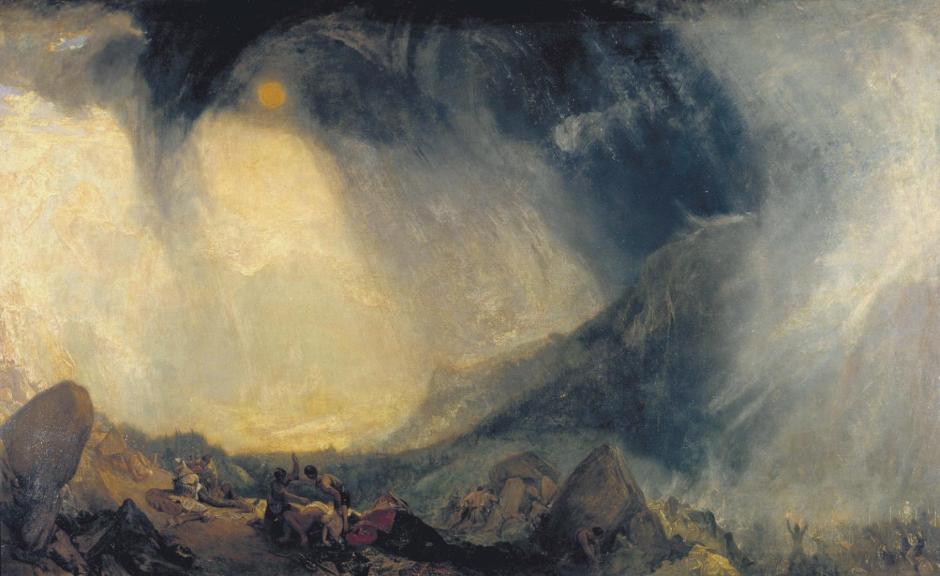In the first article of this pair looking at the intentional use of blurring in paintings, I looked briefly at its role in the depiction of aerial perspective, before looking at the special optical effects and edge control developed by Vermeer, and since adopted by artists in the late nineteenth century. Here I look through some other optical effects employed by masters, leading to deliberate defocussing of the background, and motion blur.
A couple of recognised optical illusions have been utilised in paintings: the glare and Venus effects, both of which can lead to blurring.

In 1553-55 Tintoretto used glare effect in the sky of his small masterpiece of Saint George and the Dragon. Above the saint, his quarry and the massive walls of a distant fortress is the figure of God, in a brilliant mandorla of light in the heavens. The artist used traces of vermilion and lead-tin yellow to tint this area.

In the nineteenth century, several artists started to use blurring for dramatic effect. Perhaps the best-known is JMW Turner, who often invoked turbulent storm skies, snowstorms and other phenomena to heighten atmosphere.

Inspired by his own experience of crossing Alpine passes, Turner’s sky in his radical Snow Storm: Hannibal and his Army Crossing the Alps from 1812 is among his most dramatic. He seems to have become so carried away by the towering indigo vortex of stormcloud that he almost forgot to show Hannibal’s famous elephants.
Then, after people started to see photographs which were often blurred in part, the same effects started to be used in paintings.

Eugène Burnand’s magnificent painting of Bull in the Alps from 1884 is both impressive and fascinating for his use of optical effects and extreme aerial perspective. Not only are there marked contrasts between the foreground and background in terms of chroma, hue and lightness, but Burnand has used defocussing in a photographic manner. The crisp edges of the bull stand proud of the softer edges and forms in the mountains behind. His edge hierarchy is sharpest for the bull’s head, and softest in the most distant mountain. That’s not something that he’s likely to have learned from his teacher Jean-Léon Gérôme.

At about the same time, Pierre-Auguste Renoir was experimenting with a new classically-inspired style, shown in these Young Girls Playing Badminton from about 1887. Its figures are so sharp against its landscape that they appear cut out, an effect which didn’t go down well with critics, or his dealer Durand-Ruel. Renoir abandoned it quickly.

Paul Louis Martin des Amoignes’ wonderful In the Classroom was painted in 1886. It bears unmistakeable evidence that it was either painted from photographs or strongly influenced by them. One boy, staring intently at the teacher in front of the class, is caught crisply, pencil poised in his hand. Beyond him the crowd of heads becomes more blurred.

The Ukrainian artist Max Silbert shows a similar effect in his Singing Lesson in a School in Holland from 1907. Although its realism isn’t as detailed or photographic in quality as the previous painting, it shows a similar photographic depth of field effect. The pupils closest to the artist are shown in sharp focus, and those in the further distance are markedly blurred. It’s impossible to tell whether this results from Silbert painting this work from photographs with the same blurring, or it was a deliberate effect introduced by the artist to make the painting look more photographic.
The final cause of intentional blurring in paintings is normally considered to be the most recent, in the depiction of motion, an effect which only became visible with the development of photography.

We don’t see London buses blur in this manner, and we know that in physical reality they don’t blur either. Paradoxically, this limitation in photography has become so commonplace and accepted that it has become part of our everyday perceptual experience, and has been incorporated into visual art. The first paintings using motion blur started to appear at the end of the nineteenth century, as viewers became increasingly accustomed to seeing and reading photographs.
But there’s one notable exception, a singular painting in most other respects, again painted by Diego Velázquez almost two centuries before photography.

Velázquez’ Las Hilanderas or The Spinners was long believed to depict the tapestry workshop of Santa Isabel, with spinners working in the foreground, and tapestries hanging in the background. Look at that spinning wheel, though: unlike every other such wheel before the middle of the nineteenth century, its spokes are blurred by motion, one of the few circumstances in which people were accustomed to seeing motion blur before photography.

As far as I can see, it was Thomas Eakins in 1876 who next depicted this effect, In Grandmother’s Time. He used photographic images in its preparation. At roughly the same time, other artists showed the same effect in the spokes of rotating carriage wheels.

Here’s an example from Claude Monet, in his Tulip Field in Holland (1886), where he has blurred the sails of the windmill, successfully giving the impression of their motion.

Motion blur also became popular as a visual effect in paintings of dance. Giovanni Boldini used it here in the background, and more slightly at the edges of the dancer’s clothing, so keeping the figure crisp.

Finally, Franz von Stuck appears to have used ‘flowlines’ for his Dancers (1896) rather than simple motion blur.

